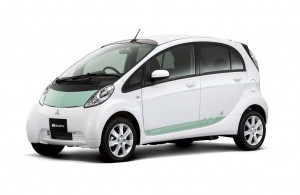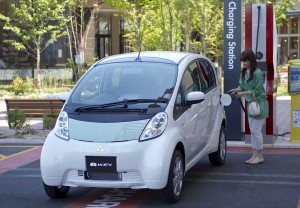
Mitsubishi plans to begin shipping its battery-electric i-MiEV to fleet customers, starting in July, with consumer sales launching in April 2010.
Mitsubishi is hoping car buyers will get wired up about its all-new battery car, the 2010 i-MiEV, which it plans to introduce for fleet sales sometime in late July of this year.
The Japanese automaker dubs the limited-volume EV “the ultimate eco-car,” describing it as describing it as “the pioneer that will open the door to the next 100 years of our automobile society.”
Quite a promise from a company that has been struggling to stay in business, in recent years, but there seems little doubt that the automotive industry is moving fast into the world of “electrification.”
The i-MiEV is the production version of an earlier show car, the Mitsubishi innovative Electric Vehicle. The production “I” version uses an innovative layout that places the hatchback’s batteries under the floor and the battery control system in the rear cargo bay.
A typical driver is expected to get about 160 kilometers, or 100 miles per charge. Mitsubishi notes that research shows 90% of Japanese drivers clock less than 25 miles a day during the week, and under 40 on the weekends.

Though it can take 14 hours for a full charge at home, the i-MiEV can reach 80% battery capacity in 30 minutes at a quickcharge station.
The i-MiEV is an entirely electric vehicle, and generates no CO2 while driving. Even considering the source of power for the average Japanese home, the automaker claims the car results in two-thirds less carbon dioxide emissions than a similar, conventionally-powered vehicle. Meanwhile, the company says smart charging systems, designed to top off the batteries at off-peak hours, will yield significantly lower energy costs on a per-mile basis.
The battery car can be charged on either 100 volt or 240 volt supplies, the latter using a special quick charger. The automaker is participating in efforts to set up a network of quick-charge stations across Japan. At home, on 100v power, charging times are fairly long, about 14 hours, but an 80% charge can be obtained in just 30 minutes, the maker claims, at one of those charging stations.
Energy is stored in 88 lithium-ion cells which, in turn, power a high-efficiency, 63-horsepower permanent magnet synchronous motor. The drivetrain uses a single-speed transmission.
An electric climate control system uses a smart controller to minimize power consumption. The LED head and taillamps further reduce battery drain.
Because of the unusual powertrain layout, Mitsubishi engineers were able to use more of the 3395 millimeter length of i-MiEV for the vehicle’s 4 passengers and cargo space.
The 2010 Mitsubishi i-MiEV will go for 4.6 million yen, including taxes, or $47,471. Initially, Mitsubishi will focus on government and corporate fleets. Retail sales will begin next April. The automaker has stated no immediate plans to sell i-MiEV outside of Japan.
Several of its rivals, however, are aiming at a global market for battery power, notably Nissan, which plans to launch its own battery car in the U.S. and other global markets – including Israel, Portugal and Denmark – by 2011.
As with its competitors, Mitsubishi is placing a costly bet on the real-world performance of lithium batteries. So far, it’s unclear whether the technology will effectively “scale up” from current consumer electronics applications, such as in cellphones and laptop computers. That’s one reason the world’s largest automaker, Toyota, has said it will wait and see before committing to lithium-powered plug-ins and battery-electric vehicles.

fantastic,
Mitsubishi MIEV can hit every electricity car on the road with its price.,
and I think I gonna buy one..